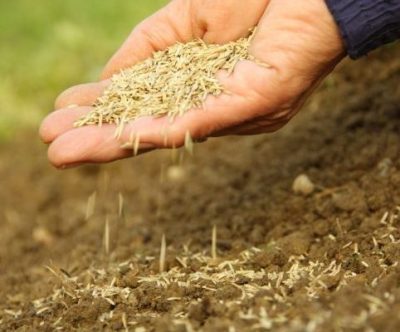- Lawn Turf
- Artificial
- Soil
- Timber
- Composite Decking
- Paving & Stone
Get In Touch With Our Experts Today!
Give us a Call! - Seed & Fertiliser
- Dressing
- Bark

May 13, 2024
To overseed your lawn can sound like a bad thing, but in fact, it’s an easy, proven, and cost-effective way to give your lawn a much-needed boost. Everyone from amateur gardeners to professional landscapers overseeds, and every type of grass may well benefit from overseeding your garden at one time or another.
In this article, we walk you through the ins and outs of overseeing: when to overseed, the best conditions for overseeding and how to overseed successfully.
Overseeing can completely transform lawns, giving them a new lease of life! It’s an essential part of lawn care and involves sowing new seeds into an existing lawn. All lawns can go through rough patches due to extreme weather conditions, general wear and tear, or animal activity. Overseeding allows you to improve the appearance of your grass in a quick and effective way.
There are numerous benefits to overseeding your turf, including:
We recommend overseeding your lawn in early spring (between March and May) or late autumn (between August and September). These tend to be the times of year when the UK has the best conditions for overseeding success.
Ideally, you want a mild day (around 13 degrees) with minimal wind so your seeds don’t blow away. And if you can skilfully plan it when rainfall is due, then you’re onto a winner as you want to keep your seeds hydrated and if it’s raining, it saves you a job!
Avoid overseeding in the summer, as the warm weather, dry soil, and low rainfall will not encourage your grass seed to flourish. You’ll actually be wasting a lot of time and effort with minimal results.
When you overseed your lawn in the right conditions, it will take your grass seeds 7 to 21 days to germinate and produce strong, dense, and healthy grass. Allow your new grass to grow to around 5cm – 8cm before cutting it on a high mower setting. You can then reduce this setting with each cut.
Unsure whether your grass needs overseeding? Your lawn will provide you with physical signs that indicate it needs some support. When you spot the following symptoms, it’s time to overseed your lawn in those areas:
The process of overseeding is a simple one. Just follow these 7 steps:
Before you start, remove any debris from the area you’re overseeding. This includes weeds, leaves, moss, twigs, etc. You want a clear canvas to seed from.
If you’re reseeding to thicken existing grass, begin by mowing your lawn at a low setting, ideally 25mm and remove the grass clippings.
Fluid movement of water, oxygen and nutrients through your soil is vital for your seeds’ potential. Use a garden fork to poke holes into your soil, giving your seeds the best chance.
If your soil looks a little tired, it might benefit from a fresh layer of top-quality topsoil which is packed full of essential seed and turf-growing nutrients.
A flat surface is an integral part of the process as it will influence the landscape of your lawn. Use a rake to even out your soil, filling in any holes or hollows.
Follow the instructions for your seeds and scatter them evenly across the area. Gently press them into the soil and water them to keep them moist.
As much as we love to feed the birds, don’t let your overseeding go to waste! Place a net over your seeds to give them a chance to bed in – our blog on protecting grass seeds can help.
There’s no right or wrong way to grow a fabulous lawn; it’s whatever works best for you and your budget. With bald or thinning grass patches, overseeding is a great solution to help your lawn thrive. It’s important to choose the right grass seed that matches your soil type and can cope with location conditions such as the amount of sunlight available, quality of drainage and how often your lawn will be used.
For larger areas of grass that need reviving, it may take a lot of time and effort to overseed. Therefore, natural turf or artificial turf might be a better option. To help you decide which is the best option for you, our grass seed vs turf blog discusses the pros and cons of each.
From diagnosing your lawn problems to recommending the best solution, our friendly team is on hand to answer your turf or seeding queries. Call or email us today.
CALL US NOW ON 01234 818 253